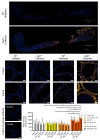The Exacerbation of Aging and Oxidative Stress in the Epididymis of Sod1 Null Mice
- PMID: 32054065
- PMCID: PMC7071042
- DOI: 10.3390/antiox9020151
The Exacerbation of Aging and Oxidative Stress in the Epididymis of Sod1 Null Mice
Abstract
There is growing evidence that the quality of spermatozoa decreases with age and that children of older fathers have a higher incidence of birth defects and genetic mutations. The free radical theory of aging proposes that changes with aging are due to the accumulation of damage induced by exposure to excess reactive oxygen species. We showed previously that absence of the superoxide dismutase 1 (Sod1) antioxidant gene results in impaired mechanisms of repairing DNA damage in the testis in young Sod1-/- mice. In this study, we examined the effects of aging and the Sod-/- mutation on mice epididymal histology and the expression of markers of oxidative damage. We found that both oxidative nucleic acid damage (via 8-hydroxyguanosine) and lipid peroxidation (via 4-hydroxynonenal) increased with age and in Sod1-/- mice. These findings indicate that lack of SOD1 results in an exacerbation of the oxidative damage accumulation-related aging phenotype.
Keywords: 4-hydroxynonenal; 8-hydroxyguanosine; aging; epididymis; oxidative stress; reactive oxygen species; spermatozoa; superoxide dismutase.
Conflict of interest statement
None of the authors has any conflict of interest.
Figures



References
-
- Wright W.W., Fiore C., Zirkin B.R. The Effect of Aging on the Seminiferous Epithelium of the Brown Norway Rat. J. Androl. 1993;14:110–117. - PubMed
Grants and funding
LinkOut - more resources
Full Text Sources
Molecular Biology Databases
Miscellaneous

